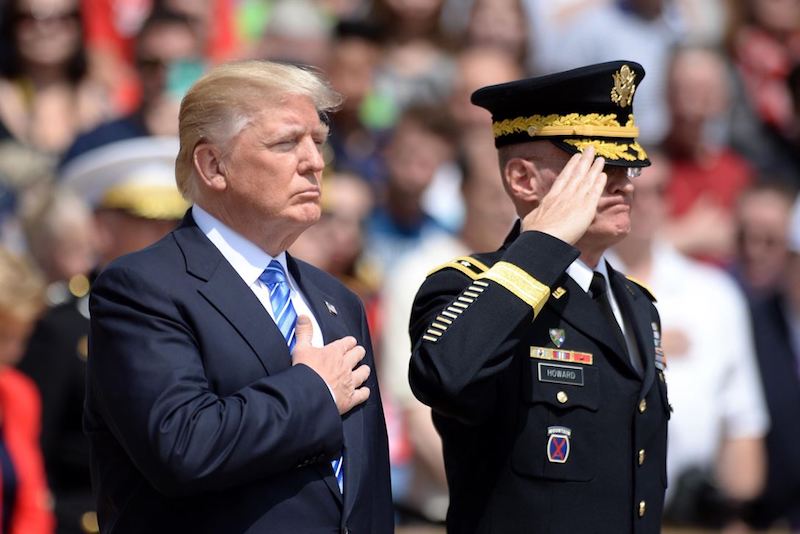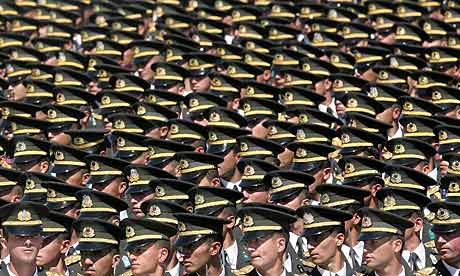The United States and its NATO partners have been at war in Afghanistan since 2001. At sixteen years, this is now the longest foreign war in American history — and it doesn’t appear to be ending anytime soon. Despite early successes against the Taliban, Afghanistan’s security situation has deteriorated significantly since the US and other coalition members began withdrawing troops in 2011.
In public testimony made to the Senate earlier this year, US Forces Afghanistan and Resolute Support Mission commander General John W. Nicholson Jr. said the war was at a “stalemate” and required thousands more troops as well as a major spending increase to turn the tides. President Trump has appeared to heed Gen. Nicholson’s call. On August 21, Trump announced that the US would remain in Afghanistan and not leave until “conditions on the ground” improved. “I’m a problem solver, and in the end, we will win,” promised Trump.
How We Got Here
Afghanistan’s Taliban-run government was toppled quickly after the US first arrived in 2001. In the aftermath, however, an insurgency arose and quickly grew troublesome. The NATO-led International Security Assistance Force (ISAF), which took full control of the effort in 2006, continued counterinsurgency efforts but the conflict appeared stagnant, if not worse. By 2010, coalition forces had begun to significantly increase troop levels in an attempt to overwhelm Taliban forces before the ISAF could reduce its involvement and hand the fight over to its Afghan allies. By 2011, the number of western troops in the country had surged to 130,000. As before, the majority came from the US which had a force of approximately 100,000 at the time. Canadian troop levels peaked at roughly 3,000.
Though President Obama had campaigned to end the war in Iraq, which he labeled a “war of choice,” he had originally emphasized the importance of Afghanistan. “I will make the fight against al-Qaeda and the Taliban the top priority that it should be,” he said as a presidential candidate in 2008. “This is a war that we have to win.” But Obama’s approach to the war shifted shortly after he became president. He appeared to quickly grow wary of foreign conflict, afraid of becoming permanently embroiled in an increasingly costly and bloody war. When President Obama announced a surge in troop commitments in 2009, he also outlined a specific timetable for their withdrawal.
The transitional process to shift the security burden from the ISAF to domestic forces began in early 2011 and NATO’s combat mission, Operation Enduring Freedom, officially ended in 2014. By 2017, most contributing countries had withdrawn the bulk of their troops leaving behind a bare force of approximately 14,000 to remain in an advisorial and training capacity. Canada’s combat role ended in 2011 though some Canadian troops remained in the country until March 2014, involved in broader efforts to train and advise Afghan forces.
As NATO and partner nations withdrew, Afghanistan began to unravel. It has yet to relent. Plagued by corruption, the Afghan government has proven unable to achieve lasting stability, nor formidable control of the country as it continues to lose large swaths of land to the Taliban and other militant factions, including a local affiliate of ISIS. The Taliban is now purportedly in control of more territory than the group has been since before Operation Enduring Freedom began in 2001.
Meanwhile, the frequency and severity of terrorist attacks have increased. A devastating attack this past May left 150 dead in Kabul. Earlier in the spring, the Taliban targeted a northern Afghan military base killing at least 140 people and delivering a significant blow to the country’s NATO-supported military efforts against the group. Although President Obama had promised to end the war by 2014, the Taliban’s resurgence forced him to pass the buck to his successor. Approximately 8,400 US troops were believed to be in Afghanistan when Trump first took office.
To Stay the Course
President Trump positioned himself as the “America First” candidate, a leader who would prioritize domestic issues over meandering foreign conflicts. As a citizen, Trump had eviscerated previous administrations’ handling of Afghanistan and frequently pushed for US withdrawal. “We have wasted an enormous amount of blood and treasure in Afghanistan. Their government has zero appreciation,” Trump tweeted in late 2013. “Let’s get out!”
His Afghanistan speech revealed a dramatic, if not reluctant, change of heart. Trump said that he “share[d] the American people’s frustration” and that his “original instinct was to pull out,” but ultimately he was convinced by his National Security team to keep forces in Afghanistan due to the putative danger of withdrawing. “A hasty withdrawal would create a vacuum that terrorists, including ISIS and Al-Qaeda, would instantly fill just as happened before September 11th [2001],” Trump said.
Though he will continue the war, the president looked to distinguish his administration’s Afghanistan strategy from that of his predecessor’s, particularly President Obama’s oft-criticized timetables for withdrawal. “Conditions on the ground, not arbitrary timetables, will guide our strategy from now on,” declared Trump. This was a welcomed shift for many foreign policy experts. Writing for the Council of Foreign Relations, Max Boot lauded the decision saying that Obama’s planned withdrawals “simply encouraged the Taliban to wait them out.”
Trump’s commitment to a strategy based on “conditions on the ground” seems logical, but it doesn’t necessarily lend itself to a clear set of strategic goals. Its vagueness also grants his administration generous amounts of ambiguity in how it informs the public about military plans. In fact, the president chose not to discuss troop numbers or specific military activities during his speech. A few days later, however, the Pentagon said a “commitment to improve the public’s understanding of America’s military commitment in Afghanistan.” The Defense Department subsequently revealed that there were actually around 11,000 US troops engaged in Afghanistan, 2,600 more than was previously reported. On September 6, it was announced that an additional 3,500 more troops were being deployed, raising the troop level to over 14,000.
Aside from the commitment to an indefinite timeline and a bump in troops, Trump’s Afghanistan strategy appears fairly similar to that of the late Obama administration’s. Like Obama, Trump’s speech emphasized the America’s role as one of support for the Afghan military in their fight against the Taliban. “The heaviest burden will continue to be borne by the good people of Afghanistan and their courageous armed forces,” President Trump said. “We are not nation building again. We are killing terrorists,” Trump also added, further distancing himself from the type of foreign interventionism he railed against during the 2016 presidential campaign.
Trump also spoke about the importance of pressing Pakistan on its “safe havens for terrorist organizations.” The president was referring to the country’s virtually ungoverned Federally Administered Tribal Area (FATA) situated along the Afghanistan/Pakistan border. This region has long been a crucial place of support and cover for Taliban insurgents as well as al-Qaeda. Again, Trump’s hardline against Pakistan further mirrors the Obama administration’s own longstanding policy towards this country.
A definite departure from the previous administration, however, is Trump’s desire to unbridle military decisionmaking, specifically that related to airstrikes. “I’ve already lifted restrictions the previous administration placed on our warfighters that prevented the Secretary of Defense and our commanders in the field from fully and swiftly waging battle against the enemy,” he said. Trump pointed to the “dramatic results” this policy of liberalization has had in the fight against ISIS in Iraq. However critics of the policy, like The Intercept’s Glenn Greenwald, have highlighted a significant uptick in civilian casualties as Trump has increased strikes in these theatres and loosened rules of engagement intended to prevent collateral damage. Other observers, like Boot, claim these concerns are overstated. In his coverage of the speech, Boot said military leaders “remain committed to the calibrated and careful use of force, so, in practice, this pillar of Trump’s strategy [(the loosening of Obama’s rules)] will make a difference only at the margins.” Still, since Trump’s assumption as president, the increase in civilian casualties attributed to the US-led coalition against ISIS has been staggering.
An Indefinite Future
In his speech, Trump requested additional troops and funding from other coalition members, particularly NATO allies. It looks like the Trump administration may get its wish. The speech was well-received by NATO’s Secretary-General Jens Stoltenberg who noted that over fifteen states had already pledged additional contributions to NATO’s Resolute Support Mission. Germany, a key member of NATO’s Resolute Support mission in Afghanistan, welcomed what it described it as a renewed “long term commitment” to the country. The European country currently has 950 troops deployed in Afghanistan.
Canada, on the other hand, again confirmed that it would not be sending troops back. It’s an understandable decision. During Canada’s thirteen years in Afghanistan, 40,000 Canadians fought, 158 of them lost their lives, over 1,800 were wounded in battle, many came home psychologically scarred, and at least $18 billion of taxpayer dollars was spent, excluding the continued costs of veteran care. And while Afghanistan remains in a precarious state with a strengthened Taliban, many foreign policy experts have been quick to note that a modest increase in coalition forces or spending is unlikely to transform the overall conflict. Moreover, there does not appear to be a consensus on what US or NATO strategy should actually look like, aside a from a continued emphasis on Afghan security forces playing a principal role in the fight.
In a piece for the Atlantic, Krishnadev Calamur was told by experts that “US troops will not make a difference unless the Afghan state begins to function better and its security forces performs better on the battlefield.” Nonetheless, James Cunningham, a senior fellow at the Atlantic Council, recommended “a low-level US presence for some time to come.” But, he also said there should exist tangible conditions to outline when the US and its allies would withdraw. Cunningham warned against any immediate US withdrawal saying it would “produce a result that’s very predictable and it’s a very bad result.”
On the other hand, Christopher Kolenda, an adjunct senior fellow at the Center for a New American Security, argued that US withdrawal would likely not turn out as bad as Cunningham warns. “Today is not September 12, 2001, and the situation in Afghanistan is very different, too,” he said. “The US intelligence and counterterror capabilities are very different. We need to bring our thinking to 2017 — and not be trapped in 2001 or 2011.”
In the end, Trump’s grand aspirations for a decisive American victory — despite the lack of a detailed, or fresh, strategy — appear unlikely. “At best, [extra] troops may help shore up coalition forces and assist the United States’ Afghan allies, preserving the stalemate,” wrote Daniel Byman, a Senior Fellow for the Brooking’s Center for Middle East Policy. Speaking to Calamur, Cunningham said that US strategy should “involve heavy political and diplomatic focus on trying to find a way to bring the conflict ultimately to an end.” This would be ideal, but with the Taliban continuing to surge, political negotiation between the warring parties looks unlikely at this point.
In his speech, President Trump started by acknowledging that the “American people are weary of war without victory.” For a long time, Trump, himself, had felt this way too. Needless to say, the same remains undoubtedly true for the Afghan people who have manifestly suffered the most during the past sixteen years. And yet, the US and its NATO coalition partners will continue this war — despite a dim future of success.
Photo by EJ Hersom on behalf of the US Department of Defense.
Disclaimer: Any views or opinions expressed in articles are solely those of the authors and do not necessarily represent the views of the NATO Association of Canada.




